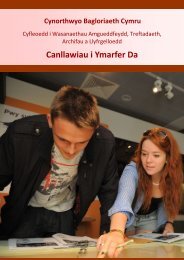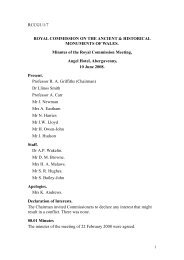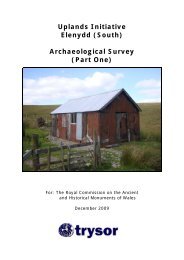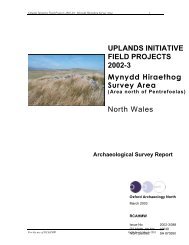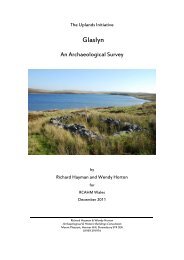Plynlimon (central) - Royal Commission on the Ancient and ...
Plynlimon (central) - Royal Commission on the Ancient and ...
Plynlimon (central) - Royal Commission on the Ancient and ...
Create successful ePaper yourself
Turn your PDF publications into a flip-book with our unique Google optimized e-Paper software.
Upl<strong>and</strong>s Initiative – Nant y Moch & Pumlim<strong>on</strong> Fawr / <str<strong>on</strong>g>Plynlim<strong>on</strong></str<strong>on</strong>g> 2004Scattered scraps of charcoal (oak, birch <strong>and</strong> hazel) were found in <strong>the</strong> <str<strong>on</strong>g>central</str<strong>on</strong>g> area, but <strong>the</strong> <strong>on</strong>ly o<strong>the</strong>rfeatures recovered were stake-holes. Twenty-eight of <strong>the</strong>se were identified (A to Z, a to e, omittingI, O, X). They were about U-3 in. in diameter, usually about 2 in., arid penetrated <strong>the</strong> subsoil to adepth of 3—4 in., G <strong>and</strong> K being about 6 in. deep. They were mostly filled with <strong>the</strong> greyish-brownclay, slightly discoloured, <strong>and</strong> were difficult to detect, while <strong>on</strong> <strong>the</strong> o<strong>the</strong>r h<strong>and</strong> over-enthusiasticinvestigati<strong>on</strong> of a mouse burrow could produce a very plausible stake-hole. Holes W, Y <strong>and</strong> Z are alittle doubtful, but are probably genuine as mouse holes were relatively scarce in that area. All <strong>the</strong>o<strong>the</strong>r twenty-three holes -were regarded as certain, but it is very probable that o<strong>the</strong>rs were notdetected or, having been utilised by mice, were regarded as entirely <strong>the</strong>ir work. Only <strong>on</strong>e (R)produced enough charcoal to identify; it was of hazel. Two of <strong>the</strong> stakes marked <strong>the</strong> positi<strong>on</strong> of <strong>the</strong><str<strong>on</strong>g>central</str<strong>on</strong>g> pot. As for <strong>the</strong> rest, <strong>the</strong> search for regularities in groups of dots is notoriously likely to giveresults, which are merely subjective, but it does seem permissible to accept it as significant thatfourteen of <strong>the</strong> holes lie between 37 in. <strong>and</strong> 54 in. from <strong>the</strong> centre of <strong>the</strong> pot. (A-G, K, M, N, S-V.)Whe<strong>the</strong>r to accept <strong>the</strong> remainder as aiming at two rings, with H, J, P, R, W between 60 in. <strong>and</strong> 74in. <strong>and</strong> Y-E between 92 in. <strong>and</strong> 115 in., must be a matter of choice.Again, it is guesswork whe<strong>the</strong>r <strong>the</strong> stakes were left st<strong>and</strong>ing when <strong>the</strong> structure was finished.Almost all could have been so, <strong>and</strong> <strong>the</strong> way in which P, in particular, lay immediately beneath agap in <strong>the</strong> st<strong>on</strong>es above suggests that it did remain. In fact, <strong>on</strong>ly five of <strong>the</strong> holes were beneathst<strong>on</strong>es. Of <strong>the</strong>se, Z is a probable but doubtful \hole; <strong>the</strong> slab over V was quite loose; <strong>and</strong> F, G <strong>and</strong> Kwere just under <strong>the</strong> edges of <strong>the</strong> slabs. All <strong>the</strong>se could be accounted for <strong>on</strong> <strong>the</strong> assumpti<strong>on</strong> that <strong>the</strong>slabs were leaned against <strong>the</strong> stakes <strong>and</strong> fell across <strong>the</strong> holes after <strong>the</strong> wood rotted.THE ASSOCIATION AND CHARACTER OF THE RING-CAIRNThe individual features of <strong>the</strong> Aber Camddwr ring-cairn can be paralleled from many sites, but areusually incorporated in barrows <strong>and</strong> are very much more carefully set out. The attenti<strong>on</strong> ofarchaeologists has tended to c<strong>on</strong>centrate <strong>on</strong> impressive mounds, so that ring-cairns have generallyescaped not <strong>on</strong>ly excavati<strong>on</strong>, but even recogniti<strong>on</strong> as a distinct class of structure. In fact <strong>the</strong>y arequite comm<strong>on</strong>, at least in Wales, though examples with entrances are unusual. The <strong>on</strong>ly o<strong>the</strong>r ringcairnexcavated in Wales before 1962 seems to be 'Circle 278' <strong>on</strong> Penmaenmawr, but this was morecarefully built <strong>and</strong> had no entrances or internal structures.In <strong>the</strong> absence of any close parallel, <strong>and</strong> pending <strong>the</strong> excavati<strong>on</strong> of o<strong>the</strong>r ring-1 cairns, <strong>the</strong> mostuseful comparis<strong>on</strong> would seem to be with <strong>the</strong> composite barrows ' of <strong>the</strong> Early <strong>and</strong> Middle Br<strong>on</strong>zeAge discussed by Sir Cyril Fox. Taken individually, all <strong>the</strong> elements found at Aber Camddwr arerepresented <strong>the</strong>re. But | apart from <strong>the</strong> fact that <strong>the</strong> excavated Glamorgan sites are all barrows, <strong>the</strong>features | found within <strong>the</strong>m are generally carefully set out <strong>and</strong> c<strong>on</strong>structed, as elsewhere, | whereas<strong>the</strong> Aber Camddwr workmanship is c<strong>on</strong>sistently poor. The stake-circles 3 under <strong>the</strong> Glamorganmounds are interpreted as representing huts, ei<strong>the</strong>r actual s or symbolic. C<strong>on</strong>sidering <strong>the</strong> AberCamddwr ring from this aspect, it becomes ' evident that <strong>the</strong>re also all <strong>the</strong> characteristics of a hutare present: <strong>the</strong> st<strong>on</strong>e bank with its entrance corresp<strong>on</strong>ds to <strong>the</strong> main wall, <strong>and</strong> <strong>the</strong> stake-holes to<strong>the</strong> rings of posts supporting <strong>the</strong> roof. To judge from <strong>the</strong> irregularity of <strong>the</strong> setting out, though, itseems likely that to <strong>the</strong> builders <strong>the</strong>se features were merely ritual elements, of which <strong>the</strong> originalsignificance had been forgotten. It is, of course, impossible to say with certainty that <strong>the</strong> stakes didnot support a roof, though <strong>the</strong> resulting structure would have been a very ramshackle affair.Equally, it is possible that <strong>the</strong> builders intended to 'complete' <strong>the</strong> structure by building a moundover it; but <strong>the</strong>re is no | evidence whatever to justify such an assumpti<strong>on</strong>.The functi<strong>on</strong> of <strong>the</strong> structure was almost certainly 'ritual'. The <str<strong>on</strong>g>central</str<strong>on</strong>g> burial of an urn c<strong>on</strong>tainingearth <strong>on</strong>ly may be compared with <strong>the</strong> <str<strong>on</strong>g>central</str<strong>on</strong>g> pits at Six Wells 267' <strong>and</strong> 2 71' <strong>and</strong> must surely beaccepted as <strong>the</strong> most important deposit <strong>on</strong> <strong>the</strong> site. The burnt remains of <strong>the</strong> child must <strong>the</strong>n beregarded as sacrificial. Indicati<strong>on</strong>s of <strong>the</strong> use of children probably as dedicatory sacrifices havebeen found at o<strong>the</strong>r Br<strong>on</strong>ze Age sites, such as <strong>the</strong> Druids Circle, Sutt<strong>on</strong> 268', <strong>and</strong> P<strong>on</strong>d Cairn.This ring-cairn, <strong>the</strong>n, can be regarded as a sacred structure incorporating, probably as ritual featuresof forgotten significance, <strong>the</strong> elements of a round house with a st<strong>on</strong>e wall <strong>and</strong> at least <strong>on</strong>e ring ofroof supports. Its locati<strong>on</strong> suggests two questi<strong>on</strong>s. Was its site deliberately chosen because of <strong>the</strong>comm<strong>and</strong>ing view? And was <strong>the</strong> c<strong>on</strong>centrati<strong>on</strong> of burials lower down <strong>the</strong> Rheidol a result of <strong>the</strong>sanctity c<strong>on</strong>ferred by <strong>the</strong> erecti<strong>on</strong> of this ring? The evidence from this site al<strong>on</strong>e provides no71CAP Report No: 355


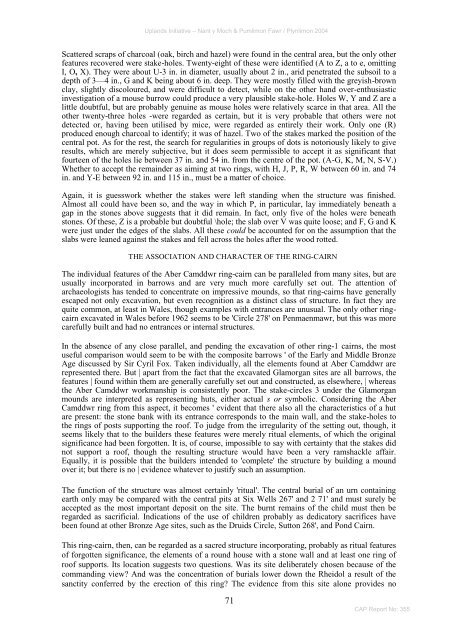

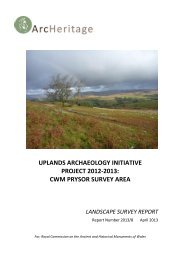
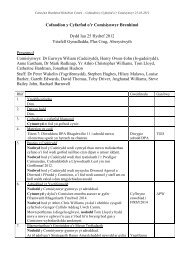
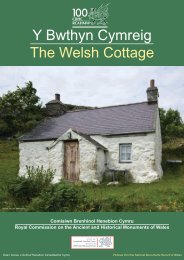

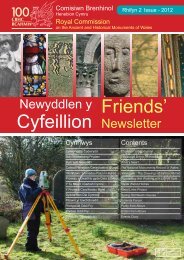
![The Source of the Usk Walk [2012 PDF]](https://img.yumpu.com/49285699/1/190x245/the-source-of-the-usk-walk-2012-pdf.jpg?quality=85)

